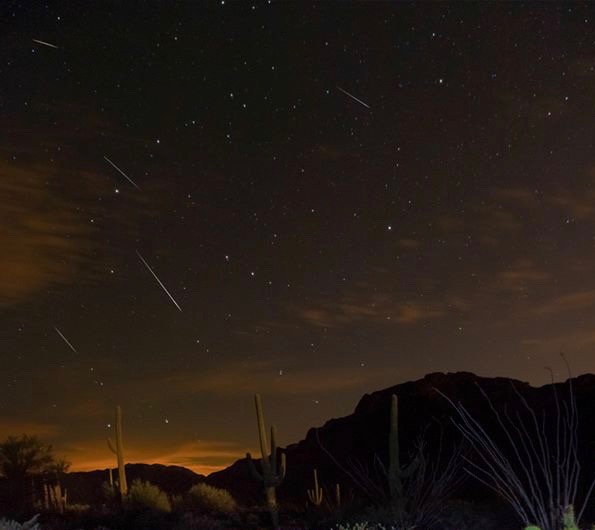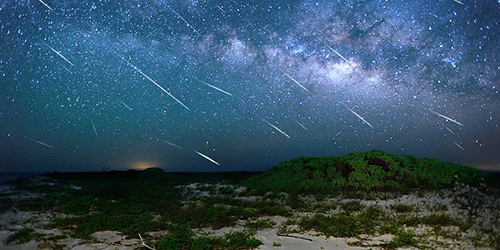The Lyrid meteor shower, one of the oldest recorded celestial events, graces the skies each April. In 2025, its brief but brilliant dance runs from April 17–26, peaking on the night of April 21–22.
Normally, 10–20 shooting stars streak by each hour—but sometimes, the heavens surprise us with bursts of up to 100, turning the sky into a glittering dream. Tilt your gaze skyward, just northeast...
The only meteor shower produced by an asteroid rather than a comet, the Geminids are not only the most numerous but the most colorful, too, with white, yellow and even green "shooting stars" possible.
When & Where: The Geminid meteor shower is worth catching on its peak night—overnight on Wednesday, December 13 through Thursday, December 14 and by 22:00 on December 13 there should be Geminids in the night sky. Look vaguely in the direction of Gemini- to the southeast, but you don’t have to be specific about it. If you want to find Gemini, turn in the opposite direction of the north star, Polaris. There you can find Orion the Hunter, with the red star Betelgeuse on the right shoulder. To the left of Betelgeuse, you can find stars Pollux and Castor at the head of the constellation Gemini.
Vancouver, BC
It's almost time...
Around the March equinox … fireball season.A fireball is just an especially bright meteor. Northern spring and southern autumn – for a few weeks around the March equinox – is a good time to see one. It’s fireball season — a time of year when bright meteors appear in greater numbers than usual. In fact, in the weeks around the equinox, the appearance rate of fireballs can increase by as much as 30 percent, says NASA.
And then finally
April 23, 2015 before dawn, the Lyrids
The Lyrid meteor shower – April’s shooting stars – lasts from about April 16 to 25. Lyrid meteors tend to be bright and often leave trails. About 10-20 meteors per hour can be expected at their peak. Plus, the Lyrids are known for uncommon surges that can sometimes bring the rate up to 100 per hour. Those rare outbursts are not easy to predict, but they’re one of the reasons the tantalizing Lyrids are worth checking out around their peak morning. The radiant for this shower is near the bright star Vega in the constellation Lyra, which rises in the northeast at about 10 p.m. on April evenings. In 2015, the peak morning is April 23, but you might also see meteors before and after that date. The waxing crescent moon will set in the evening, leaving a dark for watching this year’s Lyrid shower.
Resplendent Luminous Lustrous Shimmering Radiant
Rain makes everything beautiful
Nothing baffles the schemes of evil people so much as the calm composure of great souls. -Gabriel Riqueti Mirabeau
What is soul? Soul is conscious of good and evil, rejoicing over kindness, weeping over injury. Since consciousness is the inmost nature and essence of the soul, the more aware you are the more spiritual you are. Awareness is the effect of the spirit: anyone who has this in abundance is a man or woman of God.
-Rumi
Wake up, Become aware, leave material things behind and embrace the magnificence that surrounds you
By day each soul must walk within its shadow.
Only night can make us whole again...
Ye duniya mohabbat ki dushman ho gayi hai,
Mohabbat ab dosto kitabo me rahgayi hai,
Wo din beet gaye jab log pyar me jan diya karte
the,
Ab to husan ki pyasi duniya rah gayi hai,
Koi nahi sunta kisi ke dil ki sada,
Sabko dilon se khelne ki aadat si ho gayi hai..
The world is magnificent. Enormous.
...But compared to the
universe, it is but a spec.
FACTS
We live on planet Earth which is part of our local Solar System.
Our Solar System includes the Sun and everything that orbits the Sun.
Our Sun, is just one Star in the Milky Way Galaxy.
The Milky Way Galaxy is just one Galaxy in the Universe.
How many stars does the Milky Way Galaxy hold?
- Estimated 300 BILLION stars in only THIS Galaxy. The sun is but ONE of the stars
Ok wow, fine, huge number. But now think about this. The universe has (NASA research and Hubble Space telescope observation based)
- more than 176 billion galaxies that exist in the entire Universe!!!!!!!!!!
Just take a moment, read that again....digest.
We live on a rock, floating in the middle of somewhere. Those tiny sparkly dots you see in the sky are gigantic floating rocks as well, some thousands of times bigger than the earth or moon or sun.
Coming back to us.....
Be thankful. Do what your soul wants not what your mind pleases. Leave Ego and Pride behind. Be loyal and faithful. Be honest and true. Be YOU. The earth is an amazing place. We have but a few moments on it and we are incredibly lucky to be here. This may be the heaven 'they' speak of. Say what you feel, love who you want, help those who need it, and smile always. We are so incredibly lucky to be in the place we are today.
Difficulties are given to everyone, in different extremes. We are tested daily, throughout our lives. That is a part of life, however you interpret it.
Take a moment to think.
You live.
On a Rock
That Floats
In the sky
And is only one...of a billion
Just think of the magnitude of the universe.
We are part of it for a very short while.
Be amazed
Be thankful
You are very lucky to be here!
Such A sweet song
Sauda Hai Dil Ka - Akrosh
The delightful smell of petrichor on a warm summer day as rain gently falls onto the parched earth.
They quietly embrace the parched earth;
Those deceiving tears from the skies.
They feign to rapture wounded souls,
But they only veil weeping eyes
byZahraHabib
...let the evening come..
ooh can't wait!! Especially after discovering a new viewing area this weekend!
October 7, 2012 Draconids
The radiant point for the Draconid meteor shower almost coincides with the head of the constellation Draco the Dragon in the northern sky. That’s why the Draconids are best viewed from the Northern Hemisphere. The Draconid shower is a real oddity, in that the radiant point stands highest in the sky as darkness falls. Unlike many meteor showers, the Draconids are more likely to fly in the evening hours than in the morning hours after midnight. This shower is usually a sleeper, producing only a handful of languid meteors per hour in most years. But watch out if the Dragon awakes! In rare instances, fiery Draco has been known to spew forth many hundreds of meteors in a single hour. With no moon to interfere during the evening hours, try watching at nightfall and early evening on October 7 and 8.
Warm summer rain on a cloudy evening walking along busy streets and splashing through puddles. Visiting small speciality bakeries and narrow streets packed with shops and finishing the night at a small candlelit restaurant as the rain turns into a thunderstorm.
Perfection
Some of the Images and Videos on this site are not Original and not intended to be portrayed as being my own. They are great works of other artists which are borrowed from image/video sharing websites. If you happen to know the artist of a certain image or video here, please do get in touch so I can recognize their work. Thank you!

















































